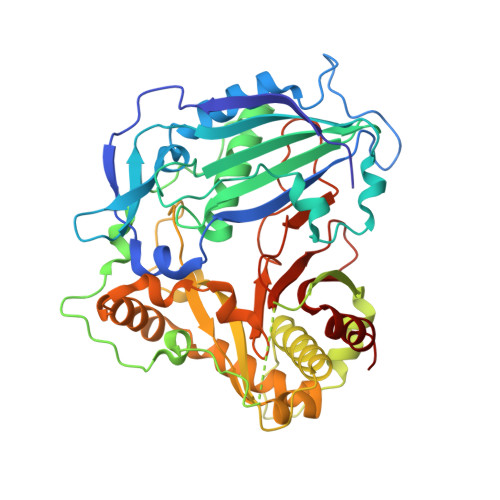Exploiting the Substrate Promiscuity of Hydroxycinnamoyl-CoA:Shikimate Hydroxycinnamoyl Transferase to Reduce Lignin.
Eudes, A., Pereira, J.H., Yogiswara, S., Wang, G., Teixeira Benites, V., Baidoo, E.E., Lee, T.S., Adams, P.D., Keasling, J.D., Loque, D.(2016) Plant Cell Physiol 57: 568-579
- PubMed: 26858288
- DOI: https://doi.org/10.1093/pcp/pcw016
- Primary Citation of Related Structures:
5FAL, 5FAN - PubMed Abstract:
Lignin poses a major challenge in the processing of plant biomass for agro-industrial applications. For bioengineering purposes, there is a pressing interest in identifying and characterizing the enzymes responsible for the biosynthesis of lignin. Hydroxycinnamoyl-CoA:shikimate hydroxycinnamoyl transferase (HCT; EC 2.3.1.133) is a key metabolic entry point for the synthesis of the most important lignin monomers: coniferyl and sinapyl alcohols. In this study, we investigated the substrate promiscuity of HCT from a bryophyte (Physcomitrella) and from five representatives of vascular plants (Arabidopsis, poplar, switchgrass, pine and Selaginella) using a yeast expression system. We demonstrate for these HCTs a conserved capacity to acylate with p-coumaroyl-CoA several phenolic compounds in addition to the canonical acceptor shikimate normally used during lignin biosynthesis. Using either recombinant HCT from switchgrass (PvHCT2a) or an Arabidopsis stem protein extract, we show evidence of the inhibitory effect of these phenolics on the synthesis of p-coumaroyl shikimate in vitro, which presumably occurs via a mechanism of competitive inhibition. A structural study of PvHCT2a confirmed the binding of a non-canonical acceptor in a similar manner to shikimate in the active site of the enzyme. Finally, we exploited in Arabidopsis the substrate flexibility of HCT to reduce lignin content and improve biomass saccharification by engineering transgenic lines that overproduce one of the HCT non-canonical acceptors. Our results demonstrate conservation of HCT substrate promiscuity and provide support for a new strategy for lignin reduction in the effort to improve the quality of plant biomass for forage and cellulosic biofuels.
- Joint BioEnergy Institute, EmeryStation East, 5885 Hollis St, 4th Floor, Emeryville, CA 94608, USA Biological Systems and Engineering Division, Lawrence Berkeley National Laboratory, 1 Cyclotron Road, Berkeley, CA 94720, USA.
Organizational Affiliation:



















